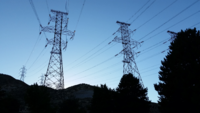
Photo from wikipedia
Abstract This paper proposes a voltage prevention and emergency control strategy that consists of coordinately arranging multiple reactive power sources in order to handle the point of common coupling (PCC)… Click to show full abstract
Abstract This paper proposes a voltage prevention and emergency control strategy that consists of coordinately arranging multiple reactive power sources in order to handle the point of common coupling (PCC) voltage fluctuation and stability in large-scale PV power plants. When a disturbance occurs at the PCC, dynamic reactive power compensation devices are coordinated preferentially to support the PCC voltage. After the disturbance is cleared, the reactive power in dynamic and fast devices is transferred into static and slow devices so that the static VAR generation (SVG) can maintain a large power margin for coping with the next disturbance. Moreover, the reactive power output of the individual inverter in PV power plants is coordinately allocated using a model to optimize the in-station voltage distribution. Finally, the effectiveness of the proposed control strategy is verified by an example simulation of a practical large-scale PV power plant.
Journal Title: Electric Power Systems Research
Year Published: 2018
Link to full text (if available)
Share on Social Media: Sign Up to like & get
recommendations!